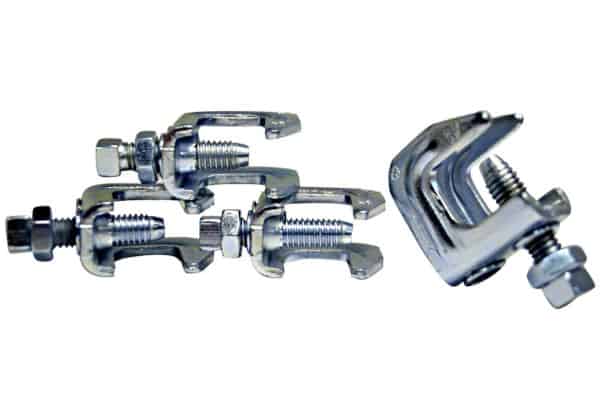Used in simple and more involved pipe hanging arrangements, top beam clamps streamline the installation of fire protection systems
Hanging pipe is certainly never “effortless”—but some methods are simpler, faster, and less complicated than others. And while there’s a wide variety of ways to approach the task at hand, top beam clamps can prove especially powerful in buildings with steel beams and other metallic supports.
To learn more about top beam clamps in fire sprinkler and standpipe systems, including common hanging arrangements, typical fire code requirements, and their use in the field, read on.
QRFS invites you to view our selection of top beam clamps designed for with standpipe systems, fire sprinkler systems, and other piping.
Top beam clamps support impressive weights in buildings with steel structural members
Pipes supplying fire sprinkler and standpipe systems with water can quickly become heavy. A pipe with a 2 1/2” inside diameter holds roughly a quarter gallon, or 2.1 pounds, of water per linear foot. And pipes serving some larger commercial systems weigh a great deal more: a pipe with a 12” inside diameter holds nearly 50 pounds of water per linear foot.
To prevent all that water from becoming a liability, those pipes are held in place by load-bearing pipe hangers. The general term “pipe hanger” covers vastly different devices. Pipe hangers may consist of a single piece that grips the pipe and secures it to some part of the building, as well as hanger assemblies that accomplish the same task with several different parts.
When choosing a hanger, the central question is: what part, or parts, of the building will support these pipes? If, for example, the assembly is supported by concrete walls or ceilings, installers may combine specialized screws (concrete anchors), brackets, and rod to connect to the hanger. But if steel structural members are available, such as I-beams—which often span over long distances with little support— contractors commonly connect to them with clamps.
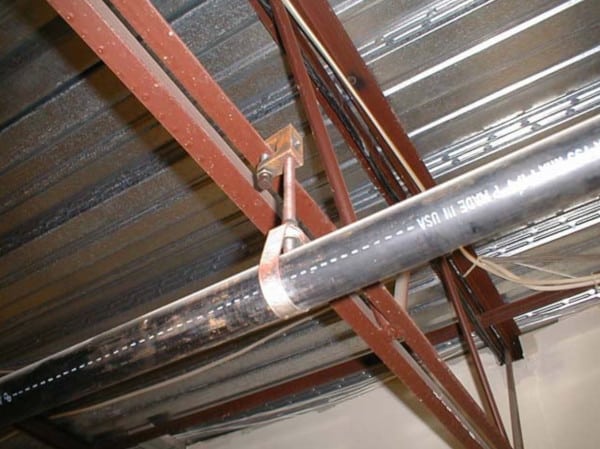
One such clamp is a top beam clamp, which attaches hanger rod to a flange—the relatively flat wing or plate that extends from the beam’s center—of a structural member. Top beam clamps are named for the flange they hold: the upper flange of an I-beam or roof truss. A top beam clamp usually includes a set screw, which allows it to grasp flanges of varying thickness, and a hole for threaded rod.
Some typical layouts for fire sprinkler system pipes are well-suited to top beam clamps
In steel construction, branch lines—the pipes that distribute water directly to fire sprinkler heads—typically run at a 90-degree angle to I-beams or joists. The cross-mains, which provide water to the branch lines, often run parallel to those metal supports (also called “structural members”).
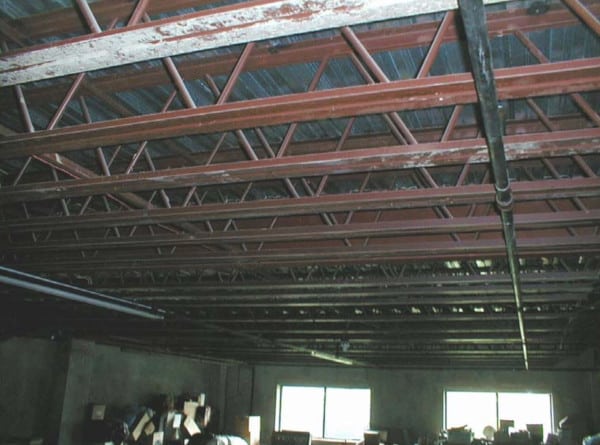
Why? Smaller pipes generally have thinner walls and, consequently, less “beam strength”—meaning that they’re more likely to fail if they have fewer, more widely spaced supports placed under greater loads. As such, smaller-diameter pipes require a greater number of supports per linear foot than do larger ones.
Because there are more branch lines in a sprinkler system than cross-mains, and because they use smaller pipe sizes, branch lines require the greatest number of hangers. Installers reduce the material needed—and the time needed to install them—by running branch lines perpendicular to those beams or joists. This provides more potential hanging points and another opportunity to use a straightforward, three-piece assembly. For a single pipe, a basic hanger assembly consists of:
- A top beam clamp
- Threaded rod
- A swivel ring
This assembly can’t be used when a pipe isn’t placed underneath a structural member—as might happen if the pipes run parallel with the beams or joists in certain configurations. Instead, installers may need to mount the rod in the ceiling with anchors (when applicable) or craft a more complex assembly called a “trapeze hanger.” This assembly suspends a pipe between two beams using two clamps, two rods, and a ring suspended from a length of metal that runs between them. Because these assemblies add labor and material costs, designers favor layouts that avoid them.
Top beam clamps must demonstrate suitability for use in fire sprinkler and standpipe systems under NFPA codes
Performance-based criteria and listings are both options for pipe hangers
Many jurisdictions throughout the United States base their local fire codes on standards written by the National Fire Protection Association (NFPA), a Massachusetts-based nonprofit organization. Many of NFPA’s codes for fire sprinkler systems are found in NFPA 13: Standard for the Installation of Sprinkler Systems. For standpipe systems, NFPA’s codes are contained in NFPA 14: Standard for the Installation of Standpipe and Hose Systems. For both NFPA 14 and NFPA 13 systems, the standards for pipe hanging are the same.
From the 2016 edition of NFPA 14
6.5 Support of Piping. Support of system piping shall be in accordance with NFPA 13.
Designers and installers can sidestep nearly all of NFPA 13’s more-specific requirements if they can demonstrate that the hangers they’ve chosen will effectively support pipe (for more, see section 17.1.2 of the 2019 edition). However, as the NFPA 13 Handbook explains, this “performance-based” option is typically reserved for situations where standard hangers won’t work (or won’t work well).
Otherwise, hangers must meet a variety of requirements that begin with testing, evaluation, and certification by a third-party for use in fire protection systems, otherwise known as “listing.”
From the 2019 edition of NFPA 13
17.1.6 Listing.
17.1.6.1* Unless permitted by 17.1.6.2 or 17.1.6.3, the components of hanger assemblies that directly attach to the pipe, building structure, or racking structure shall be listed.
A.17.1.6.1 […] If the product has been listed for use with fire protection systems, it has been shown to accommodate five times the weight of the water-filled pipe plus 250 lb (115 kg).
Section 17.1.6 does carve out some exceptions to NFPA 13’s listing requirements. But those exceptions apply only to mild steel rods, hangers formed from mild steel rods, and fasteners (like concrete anchors). They do not apply to top beam clamps, which must be listed.
UL and FM Global offer listings for top beam clamps
UL and FM Global—two leading organizations in the business of listing components used in water-based fire protection systems—consider a variety of factors in listing top beam clamps. UL’s standards are contained in UL 203, while the FM Approvals can be found in FM 1951, 1952, and 1953. Both are suitable, so long as local authorities in charge of fire code enforcement find those listings acceptable.
In FM Approvals’ standards, top beam clamps are classified as a “building attached component”—as opposed to components that connect to the fire sprinkler pipes themselves. These standards cover the strength, composition, corrosion-resistance, and characteristics of listed pipe hangers. In the case of top beam clamps, they also specify suitable rod sizes, fire sprinkler pipe sizes, and their orientation (which way a top beam clamp must face). True top beam clamps will also be imprinted with an arrow that indicates which way is “up” for the clamp.
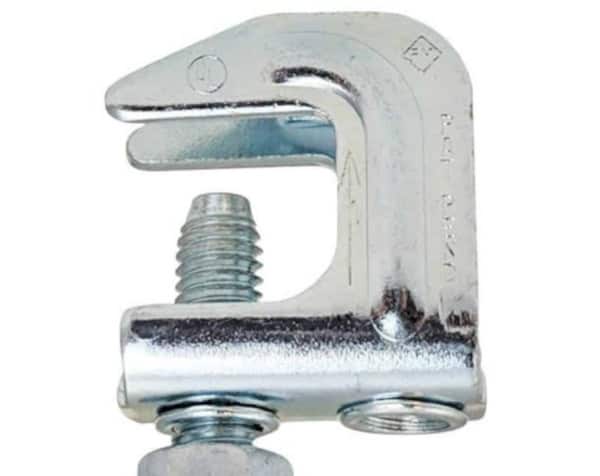
Pipe sizes provide a starting point for selecting a clamp
In most installations, 1 of 4 rod sizes will be prescribed
Top beam clamps are often described by the diameter of the threaded rod they can hold. For instance, our 3/8” top beam clamp is named for the 3/8” rod it supports—not the clamp’s size or the size of the flange it can grip. These rod diameters vary, and each size is approved for use only with some pipes. But since beam clamps are also listed for use only with specific pipe sizes, contractors can use NFPA 13’s pipe size and rod size pairings—provided in table 17.2.1.1 of the 2019 edition—to find compatible clamps for a given application. These include:
- Up to and including 4” pipe: 3/8” rod
- 5”, 6”, and 8” pipe: 1/2” rod
- 10” pipe: 5/8” rod
- 12” pipe: 3/4” rod
Although these guidelines apply broadly, smaller rods may be used when the assembly has been listed for use with that rod and the pipe size being used (NFPA 13, 17.2.1.2).
Rod size requirements also apply to trapeze hanging
These guidelines also apply in trapeze hanging, where a length of steel pipe or an angle iron (called a “trapeze member”) is supported by two rods. One question designers sometimes ask is this: do pipe hangers need to be selected and listed for the sprinkler pipe, or for the trapeze member instead (which, confusingly, may also be a pipe)?
The answer: the top beam clamps, along with rods and other components, must have the characteristics needed to support the sprinkler pipe even as part of a trapeze hanger.
From the 2019 edition of NFPA 13
17.3.5* All components of each hanger assembly that attach to a trapeze member shall conform to 17.1.6 and be sized to support the suspended sprinkler pipe.
There are situations where pairs of smaller hangers can support the loads of larger pipes. But there are also situations—particularly where the pipe isn’t suspended under the center of the trapeze member—where they won’t. This section’s caution ensures that the pipe will be adequately supported. However, professional engineers may opt to prove that smaller hangers may work in a specific application using the performance-based option discussed in the previous section.
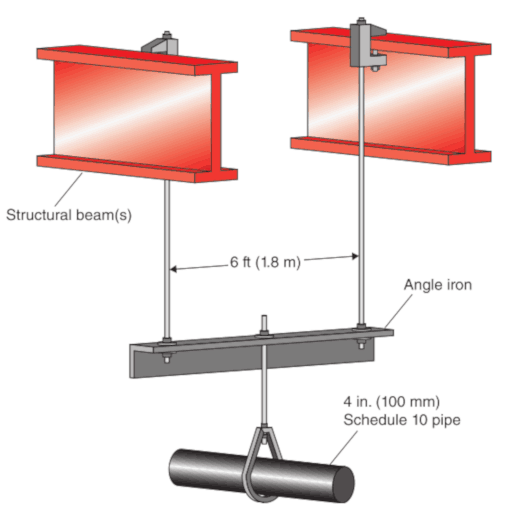
In tandem with swivel rings and other components, top beam clamps simplify pipe hanging
Designers can rely on clamps’ listings, along with the extensive set of rules contained in NFPA 13, to safely and securely support heavy pipes. Installers, on the other hand, can reduce their use of anchors, flanges, and inserts by employing clamps—and can lock the clamp in place simply by twisting a screw.
If you’d like to reap these benefits in your fire sprinkler or standpipe system, take a look at QRFS’s 3/8” SilverHawk top beam clamp. Made from cold-rolled steel, this UL-listed and FM-approved pipe hanging component can secure to a flange as thick as ¾”, and can quickly spin on to threaded rods. And with an open-back shape, this clamp allows installers to quickly ensure that that the rod is sufficiently engaged.
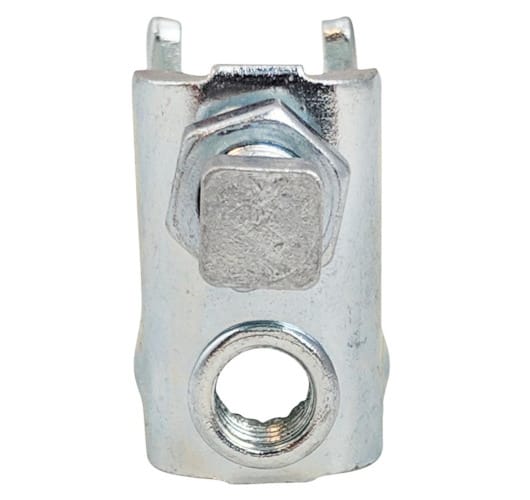
View our top beam clamps, as well as swivel rings and other pipe hanging equipment.
Questions about our top beam clamps? Need larger sizes? Call us at +1 (888) 361-6662 or email support@qrfs.com.
This blog was originally posted at blog.qrfs.com. If this article helped you, check us out at Facebook.com/QuickResponseFireSupply or on Twitter @QuickResponseFS.


